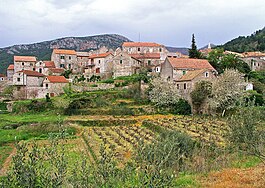
Split-Dalmatia County is a central-southern Dalmatian county in Croatia. The administrative center is Split. The population of the county is 455,242 (2011). The land area is 14.106,40 km2. Split-Dalmatia County is Croatia's most rapidly urbanising and developing region, as economic opportunities and living standards are among the highest alongside capital Zagreb and Istria County.

Novi Marof is a town in north-western Croatia, located south of Varaždin and east of Ivanec, in Varaždin County. It lies on the intersection of state roads D3 and D24 and is also connected with highway A4, state road D22 and R201 railway.

Hvar is a Croatian island in the Adriatic Sea, located off the Dalmatian coast, lying between the islands of Brač, Vis and Korčula. Approximately 68 km (42.25 mi) long, with a high east–west ridge of Mesozoic limestone and dolomite, the island of Hvar is unusual in the area for having a large fertile coastal plain, and fresh water springs. Its hillsides are covered in pine forests, with vineyards, olive groves, fruit orchards and lavender fields in the agricultural areas. The climate is characterized by mild winters, and warm summers with many hours of sunshine. The island has 10,678 residents according to the 2021 census, making it the 4th most populated of the Croatian islands.

Rudina is a small village on the island of Hvar, in the Adriatic Sea in Croatia. It is located near Stari Grad. The village has a population of 70 people. Most of the population are fishermen. There is a lagoon, Žukova, located there. Rudina has become an escape for the art community during the summer months.
Stari Grad is a town on the northern side of the island of Hvar in Dalmatia, Croatia. One of the oldest towns in Europe, its position at the end of a long, protected bay and next to prime agricultural land has long made it attractive for human settlement. Stari Grad is also a municipality within the Split-Dalmatia County.

Hvar is a town and port on the island of Hvar, part of Split-Dalmatia County, Croatia. The municipality has a population of 4,251 (2011) while the town itself is inhabited by 3,771 people, making it the largest settlement on the island of Hvar. It is situated on a bay in the south coast of the island, opposite from the other nearby towns of Stari Grad and Jelsa.

Slunj is a town in the mountainous part of Central Croatia, located along the important North-South route to the Adriatic Sea between Karlovac and Plitvice Lakes National Park, on the meeting of the rivers Korana and Slunjčica. Slunj has a population of 1,674, with a total of 5,076 people in the municipality (2011) and is the cultural and social center of the region of Kordun in the vicinity to Bosnia and Herzegovina. Administratively, the town is part of Karlovac County. Slunj is an underdeveloped municipality which is statistically classified as part of the First Category Area of Special State Concern by the Government of Croatia.

Orebić is a port town and municipality in the Dubrovnik-Neretva county in Croatia. It is located on the Pelješac peninsula on the Dalmatian coast. Orebić is directly across a strait from the town of Korčula, located on the island of the same name. Ferries service the two towns frequently. Orebić is 112 km (70 mi) from Dubrovnik.

Benkovac is a town and municipality in the Zadar County, Croatia.

Šolta is an island in Croatia. It is situated in the Adriatic Sea in the central Dalmatian archipelago, west of the island of Brač, south of Split and east of the Drvenik islands, Drvenik Mali and Drvenik Veli. The main settlement is Grohote. Its area is 58.98 km2. and it has a population of 1,700.

Jelsa is a town in Croatia, on the island of Hvar, the seat of the eponymous municipality (općina) within the county of Split-Dalmatia.

Sveti Filip i Jakov is a municipality in Croatia in Zadar County. It has a total population of 4,606, in the following settlements:

Vinica is a village and municipality in Croatia in Hrvatsko Zagorje.

Sveti Ivan Zelina is a town in Zagreb County, Croatia.

Jesenje is a municipality in the Krapina-Zagorje County in Croatia. In the 2011 census, there were a total of 1,560 inhabitants. The absolute majority of the population are Croats at 99.36%. The population is distributed in the following settlements:

Vrboska is a settlement on the north coast of the island of Hvar in Dalmatia, Croatia, in the Municipality of Jelsa. Founded in the 15th century as a fishing harbour, the town's fortress Church of Sv. Marija was built as a refuge for its inhabitants during the 16th century. Vrboska has a population of 548 at the 2011 census.

Tvrdalj Castle is a castle in Stari Grad, on the island of Hvar, Croatia.
Donje Ceranje is a village within the town Benkovac. It is 5 km (3.1 mi) south of Benkovac near the Vrana Lake.



















